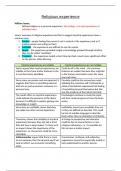MSCP summary – 23/24 – Year 1 – Term 3
Part 1 - Media Systems
Media Markets
Market structures including ownership, concentration, market shares,
audience behaviour and media access, use, etc. (How is media produced,
financed and consumed)
Polarized Pluralist: Low
Democratic Corporatist: High
Liberal: Medium/High
- Circulation of newspapers
- Processes of communication:
Horizontal: process of debate among elite (Polarized Pluralist)
Vertical: mediating between elite and citizens (Democratic
Corporatist & Liberal)
- (Absence of) sensationalist mass press/quality papers addressed to
elite readership
Political Parallelism
Media’s engagement and alliances with social groups or the relationship
between the media, journalists, and the political sphere, including political
communication and political culture. (How and in what ways is content of
media aligned with politics)
Polarized Pluralist: High
Democratic Corporatist: High
Liberal: Low
- Party-press parallelism: structure of media system parallels party
system (medium represents party affiliation)
- Political parallelism: structure of media system parallels general
political tendencies (medium represents political values or side)
Indicators:
1. Media content: extent to which media reflect distinct political
orientations
2. Organizational connections: connections between media and parties
or other social organizations
3. Politically active media personnel
4. Partisanship of media audiences: supporters of different parties
using different media outlets
5. Journalistic role orientations and practices: political or neutral
,Diversity of political loyalties and orientations:
- External pluralism: variety in media system as a whole (high PP)
- Internal pluralism: variety within each media outlet (low PP)
Governance of public broadcasting:
- Government model: broadcasting controlled by government or
political majority
- Professional model: broadcasting run by professionals, autonomous
from government
- Parliamentary (proportional) model: broadcasting control divided
among political parties by proportional representation
- Civic (corporatist) model: broadcasting control distributed among
social, political, and socially relevant groups
Three-way distinction:
1. Politics-over-broadcasting: Government model
2. Politics-in-broadcasting: Parliamentary and Civic model
3. Formally autonomous: Professional model
Journalistic Professionalization
Rules and norms of operation and evaluation of media outputs
(professional autonomy, routines, norms, associations)
Polarized Pluralist: Low
Democratic Corporatist: High
Liberal: High
Dimensions of professionalization:
1. Autonomy: (political) freedom of journalists
2. Distinct professional norms: shared ethical principles and routines
(e.g. protecting confidential sources, separate advertising and
editorial content, standards of newsworthiness)
3. Public service orientation: journalists serve the public good and are
guardians of the public trust
Instrumentalization: control of the media by outside actors (parties, social
movements, economic actors) who use them to intervene in the world of
politics
, Role of the State
Media’s relations with actors and institutions of political power, including
media policy and funding, censorship and regulation
Polarized Pluralist: High
Democratic Corporatist: High
Liberal: Low
Public service vs. commercial broadcasting:
- Public Service Broadcasting: system set up by law and generally
financed by public funds (often a compulsory license fee paid by
households) with a large degree of editorial and operating
independence (Polarized Pluralist & Democratic Corporatist)
- Commercial Broadcasting: broadcasting by privately owned
corporate media (Liberal)
Other forms of state ownership:
- State owning news agencies, newspapers, or other media-related
enterprises
- Press subsidies (direct or indirect)
- Libel, defamation, privacy, right-of-reply, hate speech laws
- Professional secrecy laws for journalists
- Laws regulating government information and political
communication
- Laws regulating media concentration, ownership, and competition
- Broadcast licensing laws and content laws
Part 2 - Political Systems
Liberalism vs. Welfare State
- Liberal democracies: weak role of the state: government should not
intervene in media (freedom of speech)
State ensures press freedom and freedom of private actors from
state intervention
United States
- Welfare State democracies: strong role of the state: healthy media
are a responsibility of the state
State expected to intervene in media markets to ensure diversity,
quality, harmony, maintenance
Europe
Difference not absolute, not a dichotomy
Part 1 - Media Systems
Media Markets
Market structures including ownership, concentration, market shares,
audience behaviour and media access, use, etc. (How is media produced,
financed and consumed)
Polarized Pluralist: Low
Democratic Corporatist: High
Liberal: Medium/High
- Circulation of newspapers
- Processes of communication:
Horizontal: process of debate among elite (Polarized Pluralist)
Vertical: mediating between elite and citizens (Democratic
Corporatist & Liberal)
- (Absence of) sensationalist mass press/quality papers addressed to
elite readership
Political Parallelism
Media’s engagement and alliances with social groups or the relationship
between the media, journalists, and the political sphere, including political
communication and political culture. (How and in what ways is content of
media aligned with politics)
Polarized Pluralist: High
Democratic Corporatist: High
Liberal: Low
- Party-press parallelism: structure of media system parallels party
system (medium represents party affiliation)
- Political parallelism: structure of media system parallels general
political tendencies (medium represents political values or side)
Indicators:
1. Media content: extent to which media reflect distinct political
orientations
2. Organizational connections: connections between media and parties
or other social organizations
3. Politically active media personnel
4. Partisanship of media audiences: supporters of different parties
using different media outlets
5. Journalistic role orientations and practices: political or neutral
,Diversity of political loyalties and orientations:
- External pluralism: variety in media system as a whole (high PP)
- Internal pluralism: variety within each media outlet (low PP)
Governance of public broadcasting:
- Government model: broadcasting controlled by government or
political majority
- Professional model: broadcasting run by professionals, autonomous
from government
- Parliamentary (proportional) model: broadcasting control divided
among political parties by proportional representation
- Civic (corporatist) model: broadcasting control distributed among
social, political, and socially relevant groups
Three-way distinction:
1. Politics-over-broadcasting: Government model
2. Politics-in-broadcasting: Parliamentary and Civic model
3. Formally autonomous: Professional model
Journalistic Professionalization
Rules and norms of operation and evaluation of media outputs
(professional autonomy, routines, norms, associations)
Polarized Pluralist: Low
Democratic Corporatist: High
Liberal: High
Dimensions of professionalization:
1. Autonomy: (political) freedom of journalists
2. Distinct professional norms: shared ethical principles and routines
(e.g. protecting confidential sources, separate advertising and
editorial content, standards of newsworthiness)
3. Public service orientation: journalists serve the public good and are
guardians of the public trust
Instrumentalization: control of the media by outside actors (parties, social
movements, economic actors) who use them to intervene in the world of
politics
, Role of the State
Media’s relations with actors and institutions of political power, including
media policy and funding, censorship and regulation
Polarized Pluralist: High
Democratic Corporatist: High
Liberal: Low
Public service vs. commercial broadcasting:
- Public Service Broadcasting: system set up by law and generally
financed by public funds (often a compulsory license fee paid by
households) with a large degree of editorial and operating
independence (Polarized Pluralist & Democratic Corporatist)
- Commercial Broadcasting: broadcasting by privately owned
corporate media (Liberal)
Other forms of state ownership:
- State owning news agencies, newspapers, or other media-related
enterprises
- Press subsidies (direct or indirect)
- Libel, defamation, privacy, right-of-reply, hate speech laws
- Professional secrecy laws for journalists
- Laws regulating government information and political
communication
- Laws regulating media concentration, ownership, and competition
- Broadcast licensing laws and content laws
Part 2 - Political Systems
Liberalism vs. Welfare State
- Liberal democracies: weak role of the state: government should not
intervene in media (freedom of speech)
State ensures press freedom and freedom of private actors from
state intervention
United States
- Welfare State democracies: strong role of the state: healthy media
are a responsibility of the state
State expected to intervene in media markets to ensure diversity,
quality, harmony, maintenance
Europe
Difference not absolute, not a dichotomy










